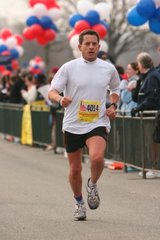*** Dara Torres. The woman sounds like a complete emotional basket case, but good for her for making the Olympic team at 41 -- and good news for middle-aged sloggers (and we know who we are). As an aside, I'd like my abs back. It appears she stole them:

An excerpt from the story:
UPON HEARING THAT TORRES is likely to make the Olympic team at age 41, many people have the same question: How is this possible? Kinesiologists counter with a different query: Why are you so surprised? “Dara is extremely impressive, but she’s not as unique as people think,” says Michael Joyner, a competitive athlete and anesthesiologist at the Mayo Clinic who writes scholarly papers about aging and sports. “Ted Williams hit .388 when he was 39. Jack Foster did very well in the Olympic marathon when he was 40. Karl Malone earned a triple-double in an N.B.A. game at 40. Jeannie Longo won a French time-trial championship in cycling at age 47.” Torres’s events — short swims — are also well suited to competitors of advanced age. Compared to, say, running, swimming is more technique-intensive and produces fewer injuries. Sprints are also kinder to older athletes, in that strength falls off more gradually than aerobic power. In April, at 37, Mark Foster, a freestyle sprinter in England, came out of retirement and earned a spot, for the fifth time, on the British Olympic swim team. “For those of us who pay attention to this stuff,” Joyner said, “Dara’s performance is unusual but not totally unexpected.”
So why do we assume a middle-aged swimmer must be all washed up? Because for nonelite athletes, sporting achievements fall off precipitously with age. Body composition changes toward more fat and less muscle. Strength and aerobic capacity decrease as well. But a primary reason that athletic performance degrades in adulthood is changes in priorities. People tend to devote more time and energy to jobs and families than to sports. Even committed athletes downgrade their workout goals from achieving personal bests to staying in shape. Academics refer to this reduction in physical activity as hypokinesis. The phenomenon is not limited to humans. A 1985 study showed that rats with unlimited access to running wheels exercised less as they aged. “But look at people who maintain activity levels,” says Joel Stager, a professor of kinesiology at Indiana University. “It’s a different story! A lot of what we assume is aging is just progressive hypokinesis. How many people at Dara’s age have maintained their training consistently? I’m going to say there are very, very few.”
Even childbirth needn’t be a sports-career killer. In 1972, in The Journal of the American Medical Association, E. Zaharieva published a study of 13 women who were pregnant and then competed in the 1964 Olympic Games. Most resumed serious training between three and six months after giving birth. All said, Zaharieva wrote, “they became stronger, had greater stamina and were more balanced in every way after having a child.” Last September, Lindsay Davenport was back on the pro tennis tour and winning just three months after giving birth, while in November, Paula Radcliffe won the New York City Marathon less than 10 months after having a baby.
So how long can peak athletic performance last? Hirofumi Tanaka, the director of the Cardiovascular Aging Research Laboratory at the University of Texas at Austin, found that both elite and nonelite runners and swimmers could maintain personal bests until age 35, after which performance declined in a gradual, linear fashion until about age 50 to 60 for runners and 70 for swimmers. Deterioration was rapid from there. Tanaka also found that swimmers experienced more modest declines than runners and that swim sprinters, like Torres, experienced the smallest declines of all. At Yale University, Ray Fair, a runner and an economist, crunched statistics on aging and peak athletic performance and created what he calls the Fair Model. The model provides a table of coefficients that enable an athlete to take a personal-best time and compute how long he or she should expect to take to complete that same event at a specific point later in life (assuming he or she has continued to train at the same level). According to the Fair Model, a woman who swam a personal best 24.63 seconds in the 50-meter freestyle at or before age 35 should expect to clock 25.37 seconds at age 41. “I am struck by how small the deterioration rates are,” Fair wrote in a paper titled “How Fast Do Old Men Slow Down?” “It may be that societies have been too pessimistic about losses from aging for individuals who stay healthy and fit.”
*** Next. Russell Means profile in the Washington Post. Eh, Russell -- have your tribal people get with my tribal people and see who got screwed over first (and longest). And general note to the part of your frontal lobe that deals with PR issues: Don't call the white reporter a racist. At least, not before the story runs. Your Dolce and Gabbana shades will be mentioned.At our first interview, over breakfast, Means was surly from the get-go. Within five minutes of shaking my hand, he accosted me for my "[expletive] white racist arrogance. There's only one reason you people came to this continent," he said. "Greed! We Indians have our spirituality. We have our land, but Americans have no culture except greed."
I changed the subject, asking Means how many Lakota backed his independence claim. "That's not germane," he barked. "In all my years of international relations, not once has anybody ever questioned my sovereignty. Even if I am only speaking for myself and my brother, and I'm not, my sovereignty exists. It's spelled out in the treaties."
Eventually, I'd learn that Means has only six or eight active Lakota supporters scattered throughout North and South Dakota. Many other Lakota quietly share his contempt for the U.S. government; some even long for a return to the hallowed days of Lakota independence. And, while Means won 46 percent of the vote when he ran unsuccessfully for Pine Ridge tribal chair in 2004, he has not endeared himself with his desperado-style secession.
*** Interesting Ben Stein column in the NYTimes on wage deflation and the price of oil. Wish it were all that simple, but it's a good point, nevertheless:But the trend is dismal. The average private worker now earns very roughly $600 a week, not counting fringe benefits. For this worker, gasoline might well account for close to one-tenth of his or her earnings. If the price of gas goes up 25 percent, the effect is serious. To put it mildly, people making $600 a week do not have a lot of leeway on spending.
As I see it, the problem is not the price of oil generally. (I think that the price will decline somewhat before long, but the long-term trend is very much up.) The problem is the stagnation of wages. Please bear in mind that the numbers I gave are averages. Skilled workers make much more. Lawyers, doctors, investment bankers, accountants, dentists — they all make more. ( I just paid two dentists a total of more than $10,000 — I am not kidding — to have one poor old tooth get a root canal and a crown, and I’m not finished with that miserable tooth yet. I paid for 90 percent of it out of my own pocket. I do earn more than the ordinary citizen, but nothing by Wall Street standards.)
But, obviously, a heck of a lot of workers make less. Imagine what it means to minimum-wage workers for gasoline to surge past $4 a gallon.
What is to be done? The federal government can do little to make the price of oil fall in the short run, except, perhaps, for one basic thing: balance the budget. The world price of oil is denominated in dollars. The dollar is weak for many reasons, but a big one is the immense budget deficits run by our government. If President Bush and Senators John McCain and Barack Obama were to stand together in front of a camera and solemnly swear that they would balance the budget in four years, even if it required tax increases on people earning millions, the dollar would rise against the euro, and oil would fall in dollars.
*** Final cool things. Went by the co-op to get some cheese, and they were giving away Silk, which (I think) is basically soy milk. They were giving away a lot of it because it was close to expiration. So we got 35 gallons of free Silk. Bad news is, it's no good for cheese or ice cream. Good news is, the pigs love it.Went by a flea market last week and found an extraordinarily sharp crosscut saw for $20. Also, a first-edition copy of "Remember the Alamo" by Robert Penn Warren. Sweet.
Youngest son made it to Arizona and back for the national youth leadership conference. Seemed to have a good time. Is still skeptical of adults in power. This is generally a Good Thing.
I'm off for a few days to get some serious day job stuff done.












No comments:
Post a Comment